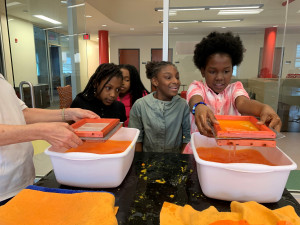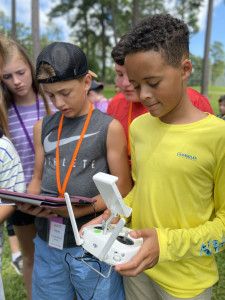 STEM & Forestry
STEM & Forestry
By Chelsea York
GFC Conservation Education Coordinator
November 8 is National STEM/STEAM Day! Chances are you’ve heard those buzzwords over the past few years, especially in the education and career fields.
So, what exactly does STEM/STEAM stand for, and how does that relate to forestry? STEM stands for science, technology, engineering, and math. STEAM incorporates another important area, the arts. Each of these fields emphasizes and fosters innovation, problem-solving, and critical thinking skills in students and the workforce.
When it comes to forestry, it’s easy to make a direct connection to science, but what about the other three fields – technology, engineering, and math? Mathematics calculates a tree’s height, diameter at breast height (DBH), and crown spread. Math is also used to determine the rate and speed that a fire will burn based on environmental factors and for computing the correct ratios of chemicals, water, and heat needed in producing paper.
 In addition to science and math, today’s foresters utilize a wide range of high-tech equipment and tools. Today’s youths are tech-savvy, and that skill set can distinguish them in certain forestry careers. A common tool used in forestry is GIS (geographic information system). GIS creates, manages, analyzes, and maps data related to its geographic location. Mills and timber harvesting crews use lasers, sensors, and advanced computer programming to increase their efficiency and optimize the use of each tree to create the least amount of waste and utilize every component of the tree. Another rapidly growing area is using drones for land mapping, prescribed fires, fire suppression and detection, and much more. Of course, with the use of technology comes the need for IT specialists – another valuable career path.
In addition to science and math, today’s foresters utilize a wide range of high-tech equipment and tools. Today’s youths are tech-savvy, and that skill set can distinguish them in certain forestry careers. A common tool used in forestry is GIS (geographic information system). GIS creates, manages, analyzes, and maps data related to its geographic location. Mills and timber harvesting crews use lasers, sensors, and advanced computer programming to increase their efficiency and optimize the use of each tree to create the least amount of waste and utilize every component of the tree. Another rapidly growing area is using drones for land mapping, prescribed fires, fire suppression and detection, and much more. Of course, with the use of technology comes the need for IT specialists – another valuable career path.
How does engineering play into forestry? Engineering is defined as a branch of science and technology that focuses on the design, building, and use of engines, machines, and structures. Engineering encompasses the use of science, mathematics, and technology. Engineering includes developing and designing new forestry-related equipment to enhance the efficiency and safety of tasks and responsibilities. In forestry, many structures, systems, and projects require this skill set, along with the important knowledge of how the natural environment. These areas include planning and overseeing the construction of culverts and bridges that can support activities such as heavy logging trucks and equipment travel.
The National Science Foundation, the Department of Veterans Affairs, the Department of Homeland Security, and the U.S. Forest Service have recently recognized forestry as a STEM Career field. STEM has always been present in forestry, but with a stronger emphasis on STEM in education and careers and the designation as a STEM Career field, we are confident forestry will be seen as a career path that offers various opportunities.
Georgia’s educators and school systems work hard to incorporate STEM and STEAM into our youths’ learning pathways. STEM is incorporated through day-to-day lessons and activities in the classroom and more tailored opportunities, such as STEM labs, field trips, or visits with STEM/STEAM Centers.
There is an abundance of resources to support educators in their STEM/STEAM journeys, but Project Learning Tree is one of our favorites that incorporates forestry and natural resources. It offers high-quality instructional materials and activities for all ages linked to national and state education standards. Activities and resources are designed to support and enhance lessons with hands-on experiences that connect children to nature. Discover ways to engage youth in science, technology, engineering, and math (STEM) with Project Learning Tree’s free STEM Strategies collection at https://www.plt.org/resources/stem-strategies/.
You can also join me online to learn how to make your paper and take a virtual tour through the papermaking process at a paper mill. Plus, download a free copy of the “Making Your Own Paper” activity from Project Learning Tree’s Explore Your Environment: K-8 Activity Guide.
